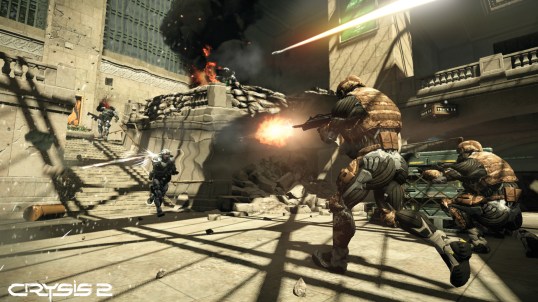The Nanosuit’s more than just the video game fetish wear responsible for your superpowers. It’s a guide, a plot point and a quasi-character that hold memories of Prophet, the last person to wear it. The abilities of the Nanosuit 2.0 make it possible to play Crysis 2 with a mix of styles, all of which you’ll need to survive its balls-hard difficulty. The form-fitting get-up gives you super-vision, super-strength, super-speed, super-durability and super-stealth to play around with. Those last two–the Armor and Cloak features–make the axis around which the gameplay’s centered. In scenario after scenario, you’ll be able to either make yourself temporarily invisible or invulnerable. Then, you can run at high speed, vault to great heights or slide under cars or obstacles. It sounds simple but there’s a lot of depth to be had with figuring out what skill to use at what moment. On top of that, you can use the suit’s tactical visor to pick out threats and parts of the environment you can use to your advantage.
The intense visuals only tell half the story of the tech powering Crysis 2. A torrent of visual information hints just how much data’s being streamed and parsed in the game’s code. That dead person over there? The visor tells you how the poor soul died, just like it can with dozens of bodies. Hundreds of objects exist to be lifted, thrown, touched and interacted with in Crysis 2. Serving a gameplay purpose is one thing but a lot of this stuff–water fountains that you drink from at your own risk–just exists to add weight and density to the gameworld.
Moving through that world, a pattern soon emerges: get to a new area, scan with visor to tag assets and enemies, figure out a strategy and have at it. It’s in that pattern, however, that you’ll start to see the game’s flaws emerge. For one, the tactical visor is great but the HUD gets way too busy. And other bugs and balance issues crop up: lost instances of enemies running into walls, a few where they spontaneously got yanked way up in the air, objects vibrating or moving unnaturally in the environment. The enemies themselves seem to have superpowers, too, like being able to shoot at you when there’s not way they have a sightline or magically knowing when you’ve uncloaked. And no matter how much you scan, it often seems like enemies are constantly re-spawning and coming after you. The creates tension, yes, but makes a lot of the strategy you have to come up with feel futile. Futilty’s another enemy that you need to face down, as Crysis 2 is pretty goddamn challenging.
Still, the core design elements–balancing stealth, invulnerability and super-movement on the fly–makes the game compelling enough to want to stick with. The level designs’ smart use of verticality and path-branching creates great cat-and-mouse battles. I’d love to be able to talk about how all of this holds up in multiplayer but these modes weren’t available to check out before the game launched. (I’ll try to get some impressions up once the servers get populated with other players.)
Despite being the console debut of Crytek’s CryEngine 3 on the PS3 and the Xbox 360, Crysis 2 isn’t exactly beckoning n00bs to come try it out. It’s still for the hardest of the hardcore with brutal difficulty that takes dedication to master. But the game, for the most part, achieves what Crytek (and presumably its fans) seem to have wanted: better story, deeper gameplay and a presence on non-PC gaming platforms. Being only March, it’s early yet but it’s safe to say that Crysis 2 will wind up a contender for Shooter of the Year.
Official Techland Score: 8.9 out of 10


